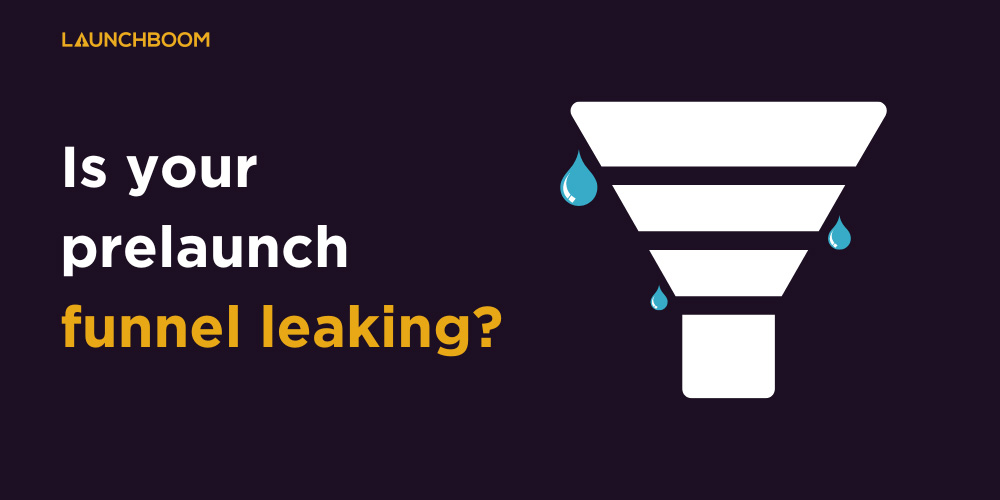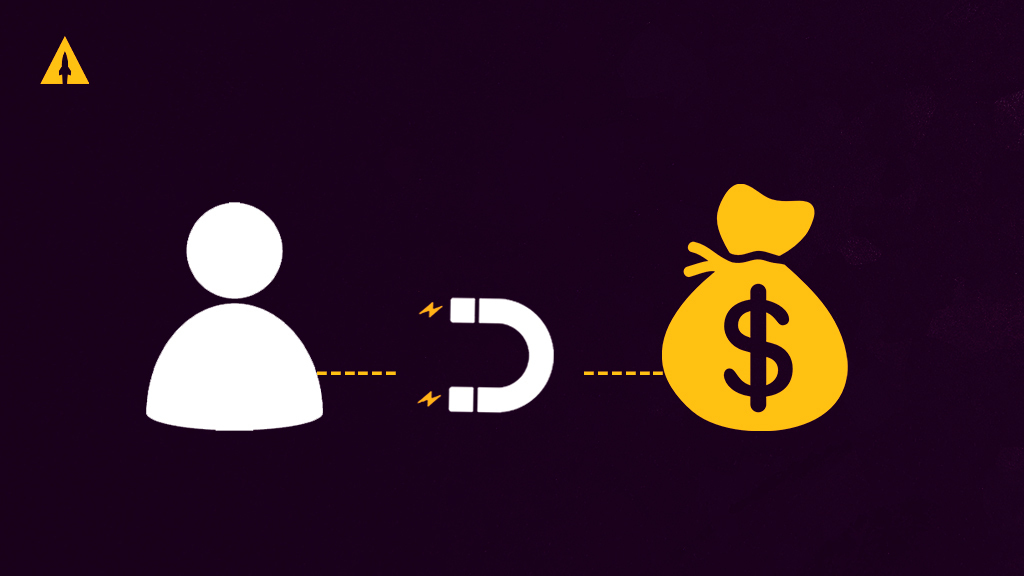
You’re about to learn which metrics are most important in your prelaunch funnel. More importantly, you’ll learn what to do when your metrics aren’t good.
Imagine a funnel with water being poured into it. Now imagine that funnel with dozens of holes in it. Water is leaking everywhere. This is obviously inefficient and should be fixed. The same is true for your prelaunch funnel. Instead of water leaking out, your visitors are leaking out. You can identify these holes using math. And once you see them, you can start to fix them.
Unfortunately, there are three reasons why most product creators struggle to fix funnel leaks:
- Don’t track the right metrics
- Don’t know if their metrics are good
- Don’t know what to do if their metrics are bad
You’re about to learn how you can overcome all of these problems easily. To start, let’s zoom out and understand the entire funnel.
How to build a watertight Reservation Funnel
The prelaunch funnel we use at LaunchBoom is called the Reservation Funnel. This funnel builds prelaunch email lists that are 30x more likely to buy your product when you launch your crowdfunding campaign. Here’s how the funnel works at a high level:
- Ads: Facebook ads drive traffic to a landing page
- Landing page: The landing page collects email addresses
- Reservation page: The reservation page collects $1 deposits (people that do this are 30x more likely to buy)

This funnel does an amazing job of building highly qualified email lists before you launch your campaign. But since there are multiple steps to this funnel, there are many chances for visitors to “leak” out of the funnel. This also means there will be many different metrics we can track.
This can be overwhelming, so below I’ll clearly state what is your goal, the most important metric to track, and the benchmark you should be shooting for.
Here’s your goal:
- Goal: To collect reservations
- Key metric: Cost per reservation (CPR)
- Benchmark: Below 20% of the price point of your product (maximum of $100 CPR).
We want your CPR to be 20% of the price point of your product. That means if your product is $100, you want your CPR to be $20 or less. If it is $1,000, you want your CPR to be $100 or less.
What does it mean if my CPR is higher than 20% of the price point of my product?
There’s a leak in your funnel.
For the rest of this blog, we’re going to go deep into how to identify these leaks. More importantly, I’ll teach you how to fix them.
Let’s start with step one of your funnel: ads.
Step 1: Ads
As the first touchpoint someone has with your funnel, ads are the hook. Your goal is to grab someone’s attention and make them click on your ad – starting them on the journey down your funnel.
Here’s your goal:
- Goal: To have someone click your ad
- Key Metric: Click through rate (CTR)
- Benchmark: 3% CTR
We want at least 3% of people who see the ad to click on it.
An ad’s performance is affected by two primary things: (1) the audience you are targeting and (2) the ad creative. For the sake of not making this post too long, I’m going to assume that your audience targeting is pretty good. Instead, we’ll focus on the creative.
What does it mean if my CTR is below 3%?
You aren’t grabbing people’s attention quickly enough.
Your ad’s creative is made up of three parts (in order of impact):
- Imagery
- Copy
- Headline

Imagery is the most important because it’s where people’s eyes go first when they see your ad. Because of this, you should test your imagery first if you are below 3.5% CTR. Do not try to test multiple variables at once because you won’t know which variable caused your CTR to increase or decrease.
Step 2: Landing page
Now that you’ve hooked them, they are hungry for answers. That’s why I call your landing page the meat – it satiates their curiosity by answering why your product will solve their problem.
Here’s your goal:
- Goal: To collect an email address (lead)
- Key Metric: Conversion rate (CR)
- Benchmark: 20% CR
We want at least 20% of all visitors to your landing page to become a lead.
Landing pages are filled with much more information than an ad. You have to answer the question “why should I want this product?” for the visitor. Because of that, there are many more variables that have an impact on the conversion rate.
What does it mean if my CR is below 20%?
People don’t think your product is going to solve their problem.
This is because you aren’t explaining why your product solves their problem well enough. Like you learned before, there are a few variables that will have a much larger impact on conversion rate than others (in order of impact):
- Hero headline
- Hero body text
- Hero image

Like the imagery in your ads, people’s eyes will go to your headline first. For this reason, we’ll test this first before testing anything else. It’s a plus that headlines are much easier to test than imagery.
Step 3: Reservation page
Every step before has required a low commitment from the person, but now is the time to really call them to commit. At this step, you offer them the chance to reserve your biggest discount by putting down a $1 deposit. A monetary commitment (even of $1) is a much higher commitment than anything they’ve done so far.
Here’s your goal:
- Goal: To collect reservations
- Key Metric: Lead to reservation rate (LTR)
- Benchmark: 4% LTR
We want at least 4% of all leads to put down a $1 deposit to become a reservation.
This is the first step where you will show your product’s retail price and the discount you will be offering. If someone puts down a $1 deposit, they will reserve that discount when you launch.
What does it mean if my LTR is below 4%?
People don’t think your product is worth it.
This means the perceived value of your product is not high enough to justify the price point. The best variable to test at this step is your price. You can do this by:
- Lowering the discount price
- Increasing the retail price

Now you know how to:
- Track the right metrics
- Know when your metrics are good
- Know what to do if your metrics are bad
When you spot a leak in your funnel, follow these steps to patch them. Little by little you’ll get closer to building a watertight Reservation Funnel. This watertight Reservation Funnel will allow you to build a highly qualified email list. This email list will allow you to have a successful product launch through crowdfunding.




